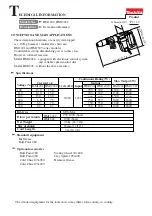
17 І 36
f)
lf the operation of power tools in a humid en-
vironment cannot be avoided, you must use
a residual current circuit breaker.
The use of a residual current circuit breaker will
reduce the risk of electric shock.
Personal safety
a)
Pay attention to what you are doing and use
power tools sensibly.
Do not use power tools when you are tired or un-
der the influence of drugs, alcohol or medication.
A single moment of inattention while using power
tools may cause severe injury.
b)
Wear personal protective equipment and
safety goggles.
Wearing personal protective equipment such as
a dust mask, non-skid safety boots, a protective
helmet or hearing protection according to the
type and application of the power tool reduces
the risk of injury.
c)
Avoid starting the power tool unintentionally.
Make sure that the power tool is switched off be-
fore you connect it to the mains and/or insert a
battery, pick it up or carry it. lf you have your fin
-
ger on the switch when you carry the power tool,
or if the machine is switched on when you con-
nect it to the mains, this may result in accidents.
d)
Remove adjustment tools or wrenches be-
fore switching on the power tool.
Tools or wrenches in rotating machine parts may
cause injury.
e)
Avoid abnormal body positions.
Stand securely and keep your balance at all times.
By doing so, you can control the power tool more
easily in unexpected Situations.
f)
Wear suitable clothing. Do not wear loose
clothing or jewellery.
Keep your hair, clothing and gloves away from
moving parts. Loose clothing, jewellery or long
hair may be trapped in moving parts.
g)
lf dust extraction tools or collection bins can
optionally be attached, you must make sure
that they are connected and correctly used.
Using dust extraction tools may reduce risks
caused by dust.
Use and treatment of the power tool
a)
Do not overload the tool.
Use the appropriate power tool for your type
of work. With appropriate power tools, you can
work better and more safely within the given
power range.
b)
Do not use power tools with defective switch-
es. Power tools which cannot be switched on
or off are dangerous and must be repaired.
c)
PuII out the plug from the socket and/or re-
move the battery before you make settings
to the tool, replace accessory parts or put
aside the power tool.
These precautionary measures will prevent the
power tool from starting unintentionally.
Please note that our equipment has not been designed
for use in commercial, trade or industrial applications.
Our warranty will be voided if the equipment is used
in commercial, trade or industrial businesses or for
equivalent purposes.
5. Safety information
m
WARNING! Read all safety warnings and all
instructions.
Failure to follow the warnings and in-
structions may result in electric shock, fire and/or se
-
rious injury.
Save all warnings and instructions for future
reference.
The term “power tool” used in the safety instructions
refers to mains powered power tools (with power
cord) and cordless power tools (without power cord).
Workplace safety
a)
Keep your workplace clean and well illumi-
nated.
Disorderliness and poorly illuminated workplac-
es may Iead to accidents.
b)
Do not operate the power tool in explosive at-
mospheres with inflammable liquids, gases
or dust.
Power tools generate sparks which may ignite
dust or vapours.
c)
Keep children and other persons away from
the power tool during operation.
You may lose control of the tool if you are dis-
tracted.
Electric safety
a)
The plug of the power tool must fit into the
socket.
Do not modify the plug in any way. Do not use
adapter plugs tagether with grounded power
tools. Unmodified plugs and matehing sockets
reduce the risk of electric shock.
b)
Avoid body contact with grounded surfaces
such as pipes, radiators, ovens and refrig-
erators. There is an increased risk of electric
shock if your body is grounded
.
c)
Keep power tools away from rain or humidity.
Water permeation into the power tool will in-
crease the risk of electric shock.
d)
Use the cable solely for its intended purpose.
Do not use the cable to carry or hang up the
power tool or to pull out the plug from the
socket.
Keep the cable away from heat, oil, sharp edges
or moving machine parts. Damaged or twisted
cables increase the risk of electric shock.
e)
When working outdoors with power tools,
only use extension cords which are suited
for outdoor areas.
Using extension cords suited for outdoor applica
-
tions reduces the risk of electric shock.
Summary of Contents for WDS 999
Page 2: ...2 І 36 ...
Page 3: ...3 І 36 2 3 4 15 1 1 9 10 7 2 3 6 4 12 5 13 14 11 8 16 17 18 19 C 3 3 12 11 14 15 10 5 ...
Page 4: ...4 І 36 9 8 7 14 15 10 6 16 1 A 10 11 B 4 13 6 5 ...
Page 34: ...34 І 36 ...
Page 36: ......
















































